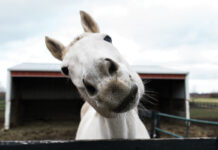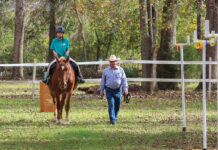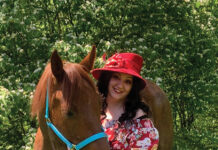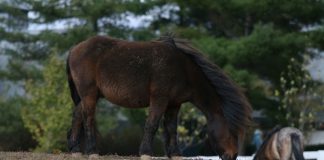Many horse owners dream of owning a home riding arena or facility. Lucky you—your dream has come true. You have the barn, your horses are happily settled, and now you’re eyeing that bare patch of ground and envisioning your dream riding arena. Many home horse riders make do with a sectioned off piece of ground near the barn that they affectionately call their arena. But this homespun effort is really an arena in name only. Without a good base and suitable arena footing, it’s difficult to make the going consistent enough for your horse’s health and safety. If you want a safe, workable arena that will hold you in good stead for years, it’s going to take planning, effort and, it must be said, an investment of resources.

Robert Malmgren, author of The Equine Arena Handbook: Developing a User-Friendly Facility, is considered the foremost authority on horse arenas. He says creating a riding arena at home on your own is very hard if not impossible because you need several players to help you avoid pitfalls.
“Making an arena seems like a lot of complications, but you’ll avoid mistakes if you plan right and employ the right people,” explains Malmgren, who is from Colorado Springs, Colo. “Mistakes are very costly to correct after the arena is installed.”
Proper Planning Prevents Problems
Before you put a shovel in the ground, sit down and get organized. Think about where you want to put the horse riding arena at home. Right next to the barn may seem convenient, but if that area collects water, think again. Drainage is an issue in every arena, so you’ll want to avoid land that’s a perpetual pond, if possible.
“As we get into global warming and climate change, we are going to have some extremes in moisture,” Malmgren adds. “This year in Colorado we’ve had some very extreme rains with a long duration of storms. That kind of rain would inundate an arena with drainage problems.”
Next, you need to determine the soil type in the site. Malmgren says to seek free assistance through people at your local office of the Natural Resources Conservation Services.
“They are the government’s soil people for the entire country,” he says. “Every county should have an office. Go in and tell them what you’re building and ask about what kind of soil you have. They usually have the information at hand, and can tell you whether it’s possible to create an arena in that area. They also provide good information, such as the percentage of sand, silt, clay and gravel in your soil. They will often come out to your site.”
Make sure to have a plat map of your property with you so the NRCS officials can pinpoint the location. They might not be familiar with the arena characteristics you require, so tell them what you need to know: type of soil, three feet in depth. Also, ask if the soil is high in clay, which is important regarding water absorption and base stability.
The next step is to obtain a permit. Getting a permit for a home riding arena might sound like overkill, but most counties require at least a grading permit if a certain amount of land is disturbed. You may also need an erosion and sediment control permit. You may not think you are disturbing that much land, but you will disturb twice as much earth as the size of your horse arena.
Even if you don’t think you need a permit, double check with your local government about its building inspection procedures because rules do change. If you begin building before proper approvals or inspections take place, your local government’s building inspection department has the right to stop the construction until proper permits and procedures are met. Sometimes this includes paying fines and penalties.
You’ll need to get yet another expert on your side—a soil consultant. Soil consultants are engineers who understand all the ins and outs of working with soil. They are the ones called in to advise facilities such as baseball fields, golf courses and parking lots. Look for a soil consultant under listings for engineering consultants.
The NRCS office may also recommend someone in your area. “A soil consultant is important because you’ll be moving soil and he’ll know how to help you do that correctly,” Malmgren says. “He can look at the NRCS’s information and tell you what you need to do to make the arena work for your situation.”
Starting at the Bottom: The Base
The base is important for a successful horse riding arena. Bottom line: You will never have a good arena without an adequate base. Your soil consultant will help determine your base requirements and if the soil will form a stable base. The base should be about six inches below the surface, if it’s a stable base. “If it isn’t stable, you might have to bring in some crushed stone to create a firm base,” Malmgren says. “You want the base to be firm because it will create a level surface for the footing above. The stone will have to be rolled when installed to create maximum hardness and evenness, and so it stays in place.”
Your topsoil might make a good base and you can put your footing right on top of it, but that’s the exception rather than the rule. Soil situations are different for everyone. It can even be vastly different within the same locale. One neighbor might have clay soil while another has sand.
Some areas of the country are subject to “frost heave” where the ground expands in the winter, causing rocks to come up to the surface. In the spring you’ll find rocks on the surface, and you’ll have to pick them up every year. The soil consultant will tell you if frost heave might occur in your area. If you have frost heave, extra heavy rolling at the time of construction will help keep your base in place. The NRCS may also give you this information at no charge.
Creating a Drain for a Riding Arena
Anyone who has had training interrupted because of a flooded arena knows how frustrating it is. Sinking money into a horse arena that sits underwater part of the year is a waste. Your soil consultant can help you avoid drainage issues.
He or she will first determine what your soil is like from the surface down to three feet deep. So perhaps you’ll have three feet of pure clay or maybe six inches of loam and then six inches of sand, followed by gravel.
“This is important to understand because you need to know how your soil handles water,” Malmgren says. “For instance, a gravel layer is going to hold some water where clay will not. If you have heavy rains, you’ll know how much water you’re going to be able to store before you have problems. And then during construction, you’ll know how to work with that.”
If your soil doesn’t drain well, don’t give up on your dream arena. There are ways you can limit flooding. You can install a French drain, which carries water away from the arena. There are several ways to create this type of drain for each area of the country. The NRCS and your consultant can help with water drainage issues.
You can also crown the arena, so that water drains off it. Or you can raise the whole arena above ground level.

What’s Underfoot in a Riding Arena?
Many types of footing additives are on the market, from shredded felt to crumb rubber to poly microfibers, but most footing “recipes” begin with sand. And any old sand won’t do. You want sand that will bind and hold together.
Sand comes in a variety of shapes; some is sharp and angular, and some is rounded. Sand performs in different ways depending upon its characteristics. It can be slippery if it’s round, like tiny ball bearings. The round grain will act like beach sand and be unsteady underfoot. It will be difficult to move through it, particularly if it’s dry.
Sharp sand binds together to hold better, which is the preferred footing for arenas. “Look at your sand grains with a hand magnifying glass if you want to get down to details, so you know what you’re getting,” Malmgren says.
Finding quality sand can be a challenge. If you have neighbors who have an arena, ask them if they are happy with their sand and where they got it. If your neighbor has a good riding arena and soil similar to yours, then you know that type of sand at your home will work for you. Also, ask how many inches your neighbor used. Footing depth ranges from two to six inches, depending upon your land situation and discipline. (For example, dressage riders generally prefer a shallower footing while reiners like deeper footing.) However, always use less footing than you think you will need. It’s easier to add more than to remove.
Sand by itself works well, but you need to be careful when watering. Too much water can flood the arena, making it unworkable for a long time. Wet sand is harder than dry sand, but very dry sand can be inefficient and create a dust problem.
Footing additives can help to improve cushion and improve traction. They also clump sand together better and prevent compaction. Some may help prevent freezing and cut down on trenching along the walls of the arena. Additives also create footing that requires less harrowing and watering. When choosing any additive, make sure that it’s manufactured for riding arenas.
Sometimes people use arenas as dumping grounds for horse manure and shavings. Although it can hold water well, manure creates a health issue for both humans and horses. The shavings also break down quickly and create a slippery surface.
Most arenas with heavy use will have a rut with half of the footing falling out of the arena. Pulling the footing back in the arena is a killer, Malmgren says. “Boards installed around the arena will solve the problem,” he advises.
“Untreated, unpainted lumber is best. I don’t like using any chemicals in an arena. If horses are turned out, they can gnaw on the boards. The height of the board depends upon the nature of your footing. If it’s a lot of footing, you’ll need bigger boards. It’s best to use higher boards because you may need to add more footing later on.”
Grass (turf) arenas are suitable under the right circumstances, depending on your annual rainfall and the type of grass. “Bunch grass doesn’t make good footing because soil is in between the plants, creating an uneven surface,” Malmgren says.
Key Takeaways
In this article, you’ve learned about building a horse arena and the DIY aspects of creating a home arena, including proper planning, the importance of the base and footing, drainage solutions, footing materials, maintenance, and grass arenas.
Read on for tips on arena maintenance so that you’re prepared to maintain your home riding arena.
This article about building a home riding arena originally appeared in the September 2007 issue of Horse Illustrated. Click here to subscribe.







Very informative. I have new ideas for my own arena.
This was intresting and verey helpful.
I will have to show this to my dad he’s going to build me an outdoor arena!
“As we get into global warming and climate change, we are going to have some extremes in moisture,” Malmgren adds. I was all bout this article until that line. figure if easily led with this climate hoax maybe knowledge of arena a little mis guided also
It’s great that you mentioned that I should talk with a soil consultant when building a horse arena because they help me avoid drainage issues. My husband and I plan to have a covered horse arena built on our property next spring. I’ll keep this in mind and ask the contractor we’ll hire if they can recommend a soil consultant. Thank you!
Choosing the correct composition for your arena footing is extremely important. Unfortunately, there are no exact, universal specifications or ratios that work for every arena. Since each arena is different, it’s up to you to decide how to proceed. However, there are specific materials that almost all arenas use to differing degrees.
My husband and I have been researching proper arena construction for a while, and I really appreciated all the information in this article! Especially in regards to footing substrate.
Thanks for the tip that I should also include a drain in the design of a horse arena. Maybe it would be best to work with a horse arena construction service in order to make sure that its size and components would be adequate. My husband has always wanted to take care of horses but we would like to make sure that the accommodations are taken care of first.
Arena sand is a great way to start cheap while holding off on footing and building on a budget. But what you may not know is you can’t approach bases the same way. Compacted bases are foundational to your backyard horse arena’s functionality, and your entire project will fall flat without a durable material.
This helped a lot I just need to get some more information! What size would be the best size for an arena for dressage and some jumping?
A dressage arena is 20mx60m. Very nice size for a home arena and will accommodate some jumping. If you plan on hosting shows you may want to go bigger. The rider usually rides around the dressage arena and enters at A when the judge signals. I am going with 20mx60m, standard dressage, which is plenty of room to practice those 20 meter circles! I should be riding on it in a month or two!!
Inadequate drainage is the second most common mistake that people make when building an outdoor equine arena. Drainage pipes should have a consistent fall and be covered with a geotextile fabric, which allows water in but keeps silt and sand out. Your drainage system should extend outside of the arena surface.